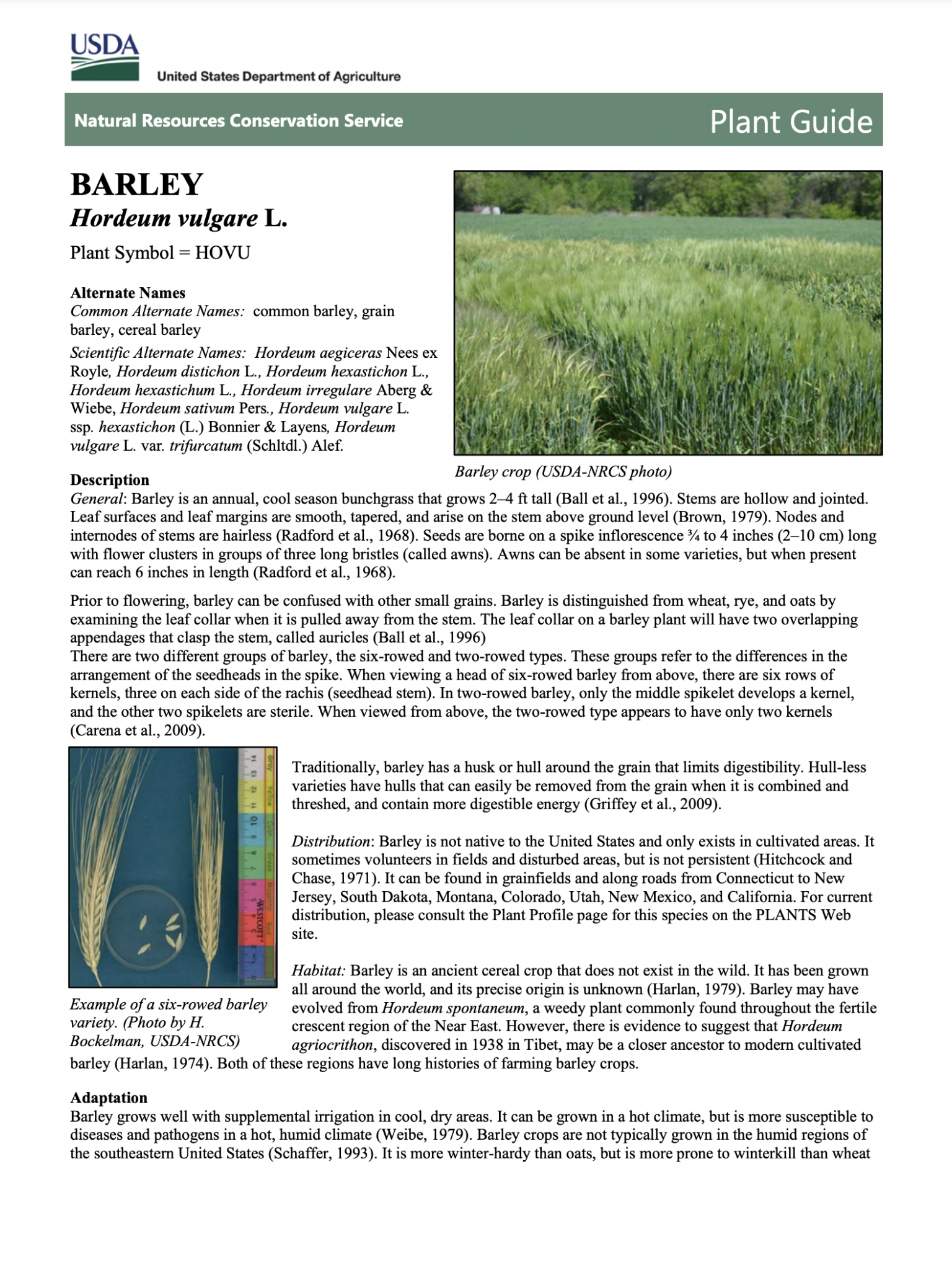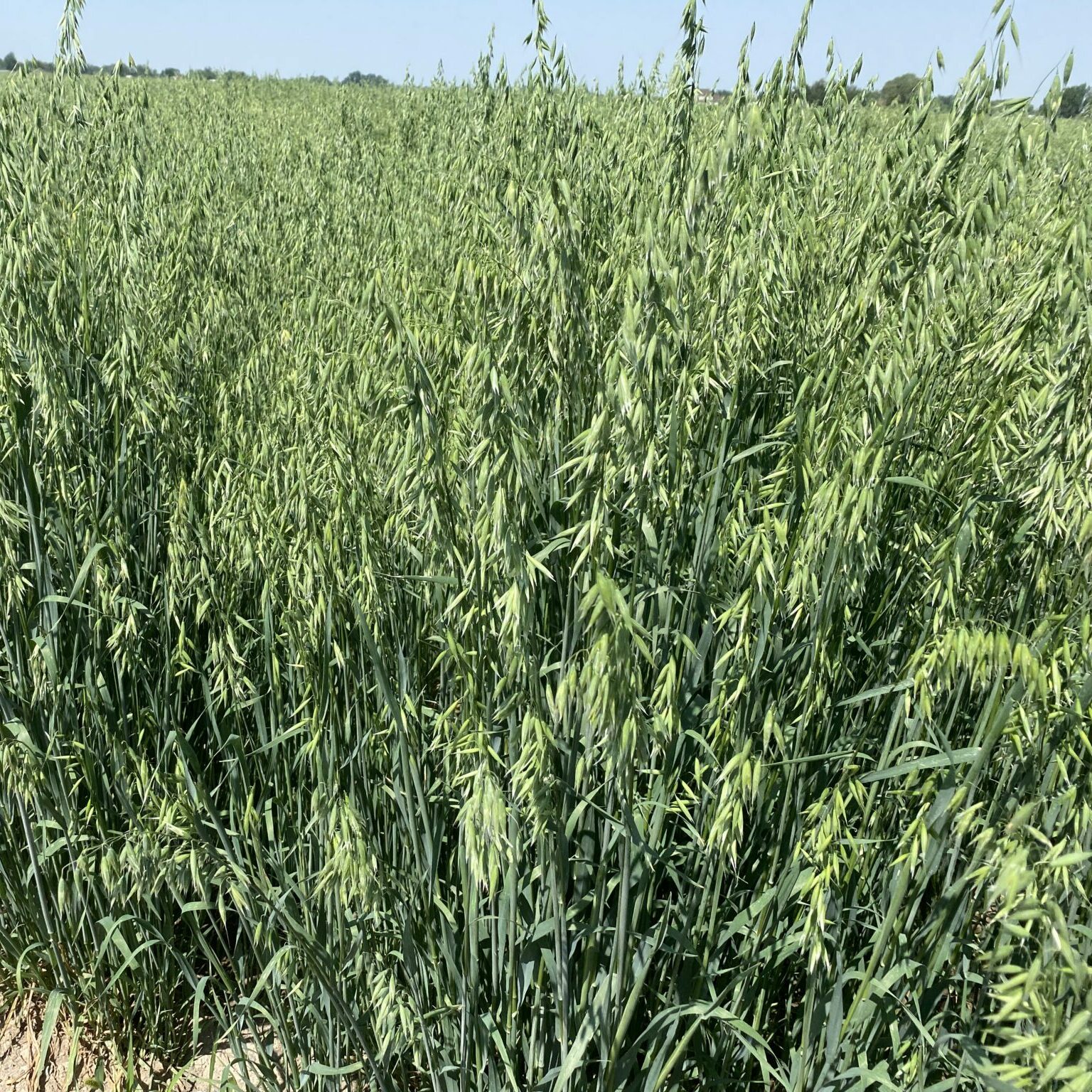Sunstar Double is a six-row facultative (winter/spring) feed barley. It was released by Sunderman Breeding Co. in 1995. It was selected from the cross Eight Twelve/Steptoe. Its experimental designation was SDM 208B. It has intermediate height and good straw strength. At the time of evaluation, it was moderately resistant to BYD and susceptible to stripe rust. It was evaluated as Entry 950 in the UC Regional Cereal Testing program from 1995-1998 for fall planting and spring planting in the intermountain region of northern California. See also Sunstar Pride Barley.
For more information visit Haystack Mtn
***Click on the “Quick Plant Facts” tab above for more information.
Barley NRCS Plant Guide and Fact Sheet
Barley NRCS Plant Guide and Fact Sheet
PDF version of NRCS Plant Guide & Fact Sheet
Citation: Jacobs, A.A. 2016. Plant guide for common barley (Hordeum vulgare L.). USDA-Natural Resources Conservation Service,
Jamie L. Whitten Plant Materials Center. Coffeeville, Mississippi.
Beards, Dwarf Beards and Awnlettes
Making Sense of Grain Beards
What is the difference between “bearded” and “dwarf beard” and “beardless” varieties? How do I choose the one best for me?
The table below will help you visualize the different characteristics of each variety, if they have beards (or not) and why it matters. See our BEARDED GRAINS blog post for additional information.
| Species | Variety | Planting Season | Beard Expression | Comments |
|---|---|---|---|---|
| Oat | Otana | Spring | Beardless | Oats do not have a beard |
| Oat | Monida | Spring | Beardless | Oats do not have a beard |
| Oat | Intimidator | Spring | Beardless | Oats do not have a beard |
| Oat | Monico | Spring | Beardless | Oats do not have a beard |
| Oat | Magnum | Spring | Beardless | Oats do not have a beard |
| Oat | Everleaf™ Falcon Oat | Spring | Beardless | Oats do not have a beard |
| Oat | Everleaf™ 126 Oat | Spring | Beardless | Oats do not have a beard |
| Barley | Vaquero | Spring | Beardless | May express a beard up to 4/10,000 plants (.04%) |
| Barley | Sunstar Double | Spring | Bearded | Bearded forage barley |
| Barley | Claymore | Spring | Bearded | Bearded forage barley |
| Barley | Haymaker | Spring | Beardless | Forage barley |
| Barley | Lavina | Spring | Beardless | Forage barley |
| Barley | Goldeneye | Spring | Bearded | Grain barley |
| Barley | Sunstar Pride | Fall | Bearded | Fall forage barley |
| Barley | Valor | Fall | Beardless | Fall forage barley |
| Barley | Baldwin | Fall | Awnletted | Beard expression if planted after October 15 |
| Triticale | Merlin Max™ | Facultative | Beardless | Forage triticale |
| Triticale | Gunner™ | Facultative | Beardless | Forage triticale |
| Triticale | 131 | Fall | Beardless | Forage triticale |
| Triticale | 141 | Spring | Awnletted | 141 was used facultatively at high elevations |
| Triticale | Luoma | Fall | Awnletted | Forage triticale |
| Triticale | Flex 719™ | Facultative | Awnletted | Forage triticale |
| Triticale | FX 1001 | Fall | Nearly Beardless | FX 1001 may have up to 3% beard expression |
| Triticale | Motley™ | Facultative | Nearly Beardless | Forage triticale |
| Wheat | Jefferson | Spring | Bearded | Hard red grain wheat for milling |
| Wheat | Twin | Spring | Beardless | Soft white forage wheat |
| Wheat | Brundage | Fall | Beardless | Soft white forage wheat |
| Wheat | Ray | Fall | Beardless | Hard Red forage or milling wheat |
| Wheat | Willow Creek | Fall | Beardless | Hard Red forage or milling wheat |
| Rye | Rymin or VNS | Facultative | Bearded | Cereal forage rye |
| Peas | Austrian Winter Peas | Facultative | Beardless | Peas do not have a beard |
| Grain Mixture | Fall Forage Blend | Fall | Beardless | May contain awnletted varieties |
| Grain Mixture | Prosper 3 Grain Forage Mixture | Spring | Beardless | Forage mixture |
| Grain Mixture | Prosper Plus with Peas | Spring | Beardless | Prosper with forage peas added |
Helpful Links
Additional information about this product can be found on the academic websites linked below.
Synonyms
Many plants have more than one common and scientific name. We've listed a few of them below.
- Sunstar Double Barley
- Hordeum vulgare
Quick Plant Facts
| Common Name: | Sunstar Double Barley |
|---|---|
| Scientific Name: | |
| Lifespan: | |
| Origin: | |
| Plant Type: | |
| pH Tolerance: | |
| Growth Height: | |
| Root Form: | |
| Planting Rate: | |
| Best Time to Sow: | |
| Max Sowing Depth: | |
| Growth Season: | |
| Sun & Shade Tolerance: | Full Sun |
| Elevation of Occurance: |





